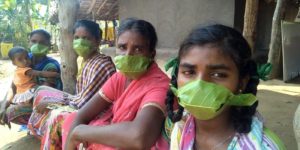
India is home to 104 million tribal people in India, concentrated in 10 different states. Spread across 705 tribes, they account for 8.6% of the country’s population. Tribal people rank the lowest in various health, educational, societal indicators.
According to the policy brief titled ‘Tribal Health in India – Bridging the gap and a roadmap for future and published jointly by the Ministry of Health and Family Welfare and Ministry of Tribal Affairs, Government of India (2018), the tribals in India are facing a triple burden of diseases.
Malnutrition, nutritional deficiencies and communicable diseases such as malaria and tuberculosis are widespread among many tribal communities. With rapid urbanisation, environmental distress and changing lifestyles, there has been a rise in the prevalence of non-communicable diseases such as cancer, diabetes and hypertension. Besides, instances of addiction of tobacco and mental illnesses is also increasing.
Tribal and other forest-dwelling communities are inevitably getting affected by COVID-19 and the lockdown. The COVID-19 hotspots identified by the government include 19 scheduled districts, while positive cases have been reported from other tribal areas as well.
The lockdown measures have had a drastic effect on a large population of poor and marginalised communities as it has caused a loss of livelihoods, physical hardships, lack of food and shelter, and economic distress. There are reports from across the country of severe hardships being faced by tribal workers, including shortage or lack of supply of ration to these communities, combined with a loss of income.
Unfortunately, the lack of a targeted healthcare plan in place for the tribals to combat COVID-19 emergency raises serious concerns about spreading of the virus in trial
Key Issues Of Tribal Communities
- Lack of healthcare facilities, COVID-19 information and testing kits
Lack of information and awareness among the tribals about the pandemic and required protective measures is a major issue in tribal areas. Tribal settlements are remotely located, making it particularly difficult for information to reach these areas. The absence of healthcare facilities can severely limit the capacity to deal with a major COVID-19 outbreak in tribal areas, posing a serious threat to the tribal population.
It is a well-known fact that COVID-19 impacts people with compromised health conditions and low immunity. This further increases the risk of widespread infection to tribal population, many of whom are living in deprivation. Allocation and monitoring of testing equipment in tribal areas is a major challenge, as testing is mostly limited in tribal areas.
- Food Insecurity, Loss of livelihood and Unemployment
Food insecurity, accompanied by malnutrition and micronutrient deficiencies, is a major cause of concern. Access to Public Distribution System (PDS) is poor as the tribals and OTFD (Other Tribal Forest Dwellers) reside remotely. Even if they are able to reach their nearby PDS centers, they are denied their share of the food material as they are not registered under the PDS center, or don’t have ration cards or Aadhaar cards.
However, the story doesn’t end here. The much publicised ‘Direct Benefit Transfer’ scheme of the government doesn’t cover this community. Most of the tribal people either don’t have a bank account or, due to their remote location, their bank accounts are not accessible to them, making the situation all the more difficult for them.
- Loss of livelihoods from Minor Forest Produce (MFP) and Non Timber Forest Produce (NTFP)
The MFP collection season begins from April and lasts uptil June, accounting for 60% of the annual collection. Unfortunately, this time, it has coincided with the lockdown period, affecting collection and the sale of these products. Research suggests that approximately 100 million forest dwellers and tribals depend on MFP for food, shelter, medicines and sustainable income. Unfortunately, the lockdown will result in ripple effects on the general health of women forest dwellers and resilience of their family members who are actively involved in collection and sale of NTFP products including bamboo, cane, fodder, leaves, gums and waxes.
The condition of Mahua flower collectors in the Odisha is an example of tribals lurch in the lockdown. Trading of these flowers during the summer season is a major source of livelihood for some tribal communities in Odissha. The COVID-19 pandemic has hurt the trade and disrupted the tribal economy as there are no flower buyers and markets are closed too.
- Tenurial insecurity and non recognition of forest rights
Due to a lack of awareness, education and resources, most of the tribals and forest dwellers don’t have recorded legal rights over forest land and resources. The tenure security of tribals and forest dwellers is key to ensuring their livelihoods and food security. The Forest Rights Act has the potential to secure forest rights of at least 20 crore tribals and other traditional forest dwellers over 40 million ha (50% of India’s forest land), covering 177,000 villages.
There are now several examples of empowered Gram Sabhas with Community Forest Resource (CFR) rights under the Forest Right Act, who have improved the productivity of their respective CFRs and are sustainably managing them. Many of these Gram Sabhas, working in the Vidharba region of Maharashtra, have generated higher revenue from the collection and sale of NTFPs, benefiting tribal collectors, while also retaining some funds for village development activities. These funds are now being utilised in a number of cases to deal with the situation created by the lockdown.
Focal Points Of Action For Tribal Communities
- A COVID-19 response plan for the tribal community must be designed by the Ministry of Tribal Affairs. Comprehensive guidelines must be framed by the central and State governments to address the issues of this section of population. These guidelines must converge the benefits of PDS and Direst Benefit Tranfer scheme for the tribals.
- With the help of mobile health units and vans, adequate testing and healthcare facilities must be ensured. COVID-19 care centres must be set up in tribal locations.
- Both the central and State governments must devise strategies to engage with forest produce traders to ensure purchase of MFPs. The tribal community collectors must connected with online buyers and sellers for their products.
- To prevent the violation of rights of tribal communities and forest dwellers, the environment ministry must withdraw the forest clearance decision and other such guidelines issued during the lockdown .
- Compensatory Afforestation Fund Management and Planning Authority (CAMPA) should release funds to Gram Sabhas established with the tribal community for management of forest resources and livelihood activities to address the economic crisis due to COVID-19 lockdown. Post the lockdown, CAMPA should release job opportunities for tribal community members.
- Effective implementation needs of the Forest Right Act needs to be in place to ensure tenurial security and recognition of forest rights of tribal people.
Courtesy : Preeti Khanna in #CoronaWatch, Society

